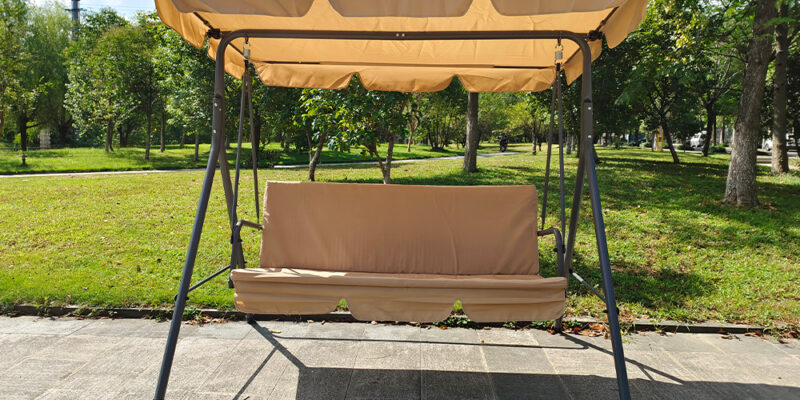Porch swings have long been a symbol of comfort and relaxation in outdoor living spaces. Whether it’s the soft sway in the breeze or the inviting seat where you can unwind after a busy day, porch swings offer an unparalleled level of enjoyment. Over time, however, the seat can wear out or become damaged, and when that happens, you may find yourself needing a porch swing seat replacement. Knowing how to go about replacing your porch swing seat not only restores comfort but can also revitalize the look of your outdoor area. In this guide, we’ll explore the steps, materials, and considerations to help you with your porch swing seat replacement.
Understanding When It’s Time for a Porch Swing Seat Replacement
The most obvious reason for replacing a porch swing seat is when it becomes uncomfortable or unsafe to use. Over the years, exposure to the elements, such as rain, sun, and wind, can cause the fabric or wood to deteriorate. A broken or sagging seat can be hazardous, especially if the frame of the swing is still in good condition. If your porch swing has been a part of your outdoor decor for a while and you’ve noticed fraying, tears, cracks, or severe discomfort, it’s probably time to think about a porch swing seat replacement.
Additionally, if you’ve recently purchased a new swing frame or want to update the aesthetics of your outdoor space, replacing the seat offers a chance to completely transform the look and feel of your swing. A fresh seat can not only restore comfort but can also breathe new life into the entire area.
Materials and Options for Porch Swing Seat Replacement
When it comes to porch swing seat replacement, there are various materials and styles available to suit your needs. The material you choose for your replacement seat should complement the overall design of your outdoor space, but also consider durability, comfort, and ease of maintenance.
For those looking for traditional appeal, wooden swings remain a classic option. Wood can offer sturdy support, and the right type of wood can withstand the weather when properly treated. Popular wood choices for porch swing seats include teak, cedar, and pine. These materials are known for their durability and ability to hold up against rain and sun. However, wooden seats may require occasional sanding, sealing, or painting to maintain their condition.
Alternatively, fabric seats offer a softer and more versatile option. For a fabric porch swing seat replacement, you can select from a range of outdoor-friendly fabrics such as polyester, Sunbrella, or canvas. These materials are designed to resist fading, mold, and mildew, making them an ideal choice for outdoor use. Upholstered seats offer a variety of color and pattern options, allowing you to match the swing to your patio or porch’s decor.
Finally, for those seeking a balance between style and durability, wicker or resin-based materials make for excellent porch swing seat replacements. Wicker swings are often paired with cushions or pillows, providing both comfort and charm. Resin wicker is particularly resilient, offering a more modern look while being resistant to damage from the elements.

How to Replace a Porch Swing Seat
Replacing the seat on your porch swing may seem like a daunting task, but with a little know-how and the right tools, it can be a straightforward DIY project. Here are the basic steps you’ll need to follow for your porch swing seat replacement.
Step 1: Measure the Existing Seat
Before you begin replacing your swing seat, it’s important to measure the dimensions of your current seat or the frame of the swing. This will ensure that the new seat will fit properly. Measure both the length and width of the seat area, and if you’re working with a wooden swing, be sure to measure the spacing between the slats, as well as the overall height of the seat from the frame.
Step 2: Choose the Right Seat Material
Once you have your measurements, it’s time to select the material for your new seat. If you’re opting for a fabric swing seat, you’ll need to choose a fabric that’s durable and weather-resistant. Look for outdoor fabrics designed to resist fading and mold, and consider adding cushions for extra comfort.
If you’re replacing a wooden seat, consider the wood’s thickness and whether it needs to be treated or sealed for outdoor use. For woven or resin wicker replacements, make sure the material you choose is compatible with your existing frame.
Step 3: Remove the Old Seat
With the new seat material selected, begin by removing the old seat. For fabric swing seats, this may involve unscrewing or untying the seat from the frame. If the seat is secured by staples or nails, carefully use a flathead screwdriver or pry bar to lift these fasteners and remove the old fabric.
For wooden or slatted swing seats, you may need a drill to remove screws or nails holding the seat slats in place. Be cautious not to damage the frame of the swing during removal, as this can affect the overall stability of the swing.
Step 4: Install the New Seat
After the old seat is removed, it’s time to install the new one. For fabric replacements, you may need to attach the fabric to the swing frame using screws, bolts, or ties. Be sure to pull the fabric tight to avoid sagging, and make sure it’s securely attached at all corners.
For a wooden seat, carefully position the new wood slats and use screws or nails to attach them to the frame. Make sure to check that each slat is evenly spaced and securely fastened for both comfort and safety.
If you’re opting for a wicker or resin-based seat, follow the manufacturer’s instructions for assembly, as these materials may come in panels or pre-woven sections that need to be connected to the frame. Be sure the material is tightly secured and doesn’t shift during use.
Step 5: Final Adjustments
Once the new seat is in place, give it a test by gently pressing down to make sure it’s secure. Ensure the swing moves smoothly and that there are no loose parts or uncomfortable pressure points. If necessary, make adjustments to the tightness of the fabric or re-position the wood slats for an even distribution of weight.
Also, consider adding cushions or pillows to enhance comfort. For fabric seats, be sure that the cushions are designed for outdoor use, so they resist mildew and fading. Cushions can also give your porch swing a fresh, updated look.
Maintaining Your Porch Swing Seat
A porch swing seat replacement can breathe new life into your outdoor space, but it’s important to maintain the seat for longevity. For fabric seats, regular cleaning is key to preventing dirt buildup and mildew growth. Wipe down the seat with mild soap and water, and use a fabric protectant spray to preserve the material.
Wooden seats may require periodic sanding, sealing, or staining to maintain their appearance and prevent weathering. If your porch swing seat is exposed to direct sunlight, you may want to apply UV protection treatments to preserve the color and texture of the wood.
Wicker and resin materials generally require less maintenance, but regular cleaning with a soft brush or cloth can keep them looking fresh. Avoid using harsh chemicals that could damage the finish.
A porch swing seat replacement offers the opportunity to restore comfort, safety, and style to your outdoor living area. Whether you’re replacing a fabric, wooden, or wicker seat, understanding the materials available and following the steps for proper installation will ensure a successful project. By maintaining your new seat and making the right choices in material, you can continue to enjoy your porch swing for many years to come.






Comments